BEACH users say their calls for immediate action to halt erosion at one of Mornington’s popular family swimming beaches are being ignored, while authorities say erosion is a natural part of “climate change”.
Despite years of complaints, and evidence suggesting Shire Hall Beach is literally disappearing, a group campaigning for urgent remedial works say authorities have not undertaken “due diligence” and the beach has become “dangerous”.
Alannah Batho said her mother recently broke her leg at the beach while attempting to step from the family’s beach box on to the sand below, which has receded over the past few years to expose a rocky surface.
Ms Batho and others believe the erosion has been caused by Parks Victoria’s construction of a 123 metre wave screen at nearby Mornington harbour a decade ago as part of a safe harbour project for moored boats.
An environmental effects statement for the proposal found that “coastal processes will change as a result of the wave screens and reduction of wave action. Changes will be evident through an increase in beach erosion from Shire Hall Beach and accretion onto Scout Beach and little change to beach morphology at Mothers Beach”.
Modelling by consultants Water Technology indicated that the construction of the safe harbour was expected to result in the annual redistribution of about 1000 square metres of sand from Shire Hall Beach to Scout Beach, with a reliability of such sand movement ranging from 0.5 to 2 times the volume.
Although the studies were done on larger wave screens that were originally part of the safe harbour proposal, Ms Batho, a lawyer, says it is “evident” that wave screens impact nearby beaches.
She says that despite knowing this, there were no conditions attached to the wave screen permit for either Mornington Peninsula Shire Council or the Department of Environment, Land, Water and Planning (DELWP) to maintain the condition of the surrounding beaches.
“The beach has now become so degraded that I have begun taking my one-year-old daughter, Bonnie, to other beaches because it is not safe or enjoyable for babies and little kids,” Ms Batho said.
“I have seen parents digging trenches through the rocks so their kids can get out to the sand for swimming … I have also seen little kids stuck on one side of the rocks, crying, and their parents struggling to reach them.”
Ms Batho said letters had been sent to DELWP, Parks Victoria and the council by residents and the Mornington Environment Association.
“Unfortunately, these bodies have refused to do anything to rectify the issue … I have copies of many of these letters and emails and the responses from the relevant bodies are very lacklustre,” she said.
Solutions to the erosion suggested in the safe harbour EES included monitoring the beaches, annual sand replenishment, and building an artificial reef.
A council spokesperson said the shire was aware of the erosion at Shire Hall Beach and had alerted Parks Victoria, which works in conjunction with DELWP.
But DELWP’s regional director Port Phillip, Stephen Chapple, said the erosion was a “naturally occurring process that affects many parts of Victoria’s coastline”
“Coasts are dynamic environments that can change rapidly, they are impacted by storms that are increasing in severity and frequency due to climate change,” he said.
“Shire Hall Beach is located at the eastern end of a heavily modified embayment. The beach partly overlays a rocky reef that is periodically exposed and buried as sand moves with seasons and weather events.
“Shire Hall Beach has not been identified as a priority for the Port Phillip beach renourishment program.”
In the past three years the state government has spent $8 million in beach renourishments across Port Phillip, with the emphasis on “protecting critical public infrastructure”.




